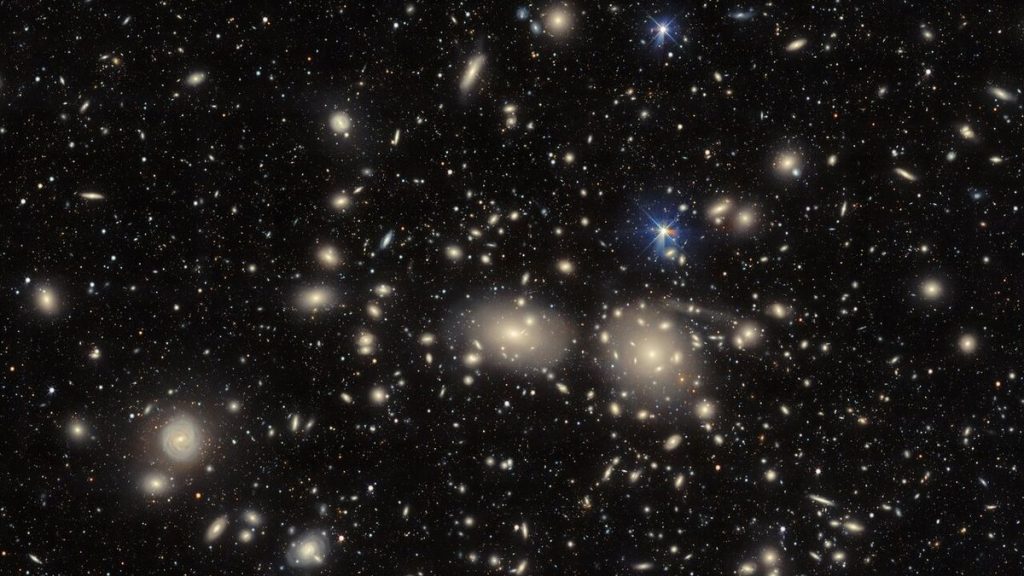
Dark Energy Camera’s new galactic portrait delves into dark-matter central (Image Credit: Space.com)
The Coma Cluster of more than 1,000 galaxies is resplendent in this new image from the powerful Dark Energy Camera (DECam) situated in the four-meter Victor M. Blanco Telescope at the Cerro Tololo Inter-American Observatory in Chile.
Located about 321 million light-years away from us in the constellation of Coma Berenices, the Coma galaxy cluster has made a significant mark in our study of dark matter. In 1937, it was within this cluster where Caltech astronomer Fritz Zwicky first found evidence for the existence of dark matter. He noticed that the galaxies in the cluster were moving faster than the gravitational field generated by all the cluster’s visible matter should allow. In fact, the galaxies were moving so fast that, by all rights, they should have flown right out of the cluster and escaped into deep space. Zwicky thus deduced that there must be a substantial amount of invisible, or “dark,” matter present in the Coma Cluster, but his ideas at the time were considered too radical.
It was only in the late 1960s and early 1970s, when Vera Rubin and Kent Ford systematically found evidence for dark matter in galaxies by studying their rotation curves — that is, how fast the stars and gas in those galaxies are moving — that astronomers became serious about dark matter.
Today, we know that 90% of the mass of the Coma Cluster is made from mysterious dark matter.
Since those early dark matter milestones, a combination of observations and theory have also resulted in the standard model of cosmology, which depicts a universe threaded by a cosmic web of dark matter and laced with normal matter in the form of gas and dust. Galaxies tend to form along the filaments of this web, and at the nodes of the web where the filaments interlink, we find galaxy clusters.
Related: Dark Energy Camera captures record-breaking image of a dead star’s scattered remains
A 2020 study from a team led by Nicola Malavasi of the Ludwig–Maximilians–Universität in Germany found that the Coma Cluster is linked to three separate cosmic-web filaments, with two of the filaments particularly prominent. Dark matter, gas and even whole galaxies flow along the filaments and fall into the Coma Cluster where the filaments meet. One of the filaments is found on the west side (from our point of view when seen on the sky) of the cluster and coincides with an X-ray emitting shockwave generated by infalling matter from the filament colliding with the intra-cluster medium — that is, the hot gas that fills the space between the galaxies in the cluster.
Another filament is found connecting the north-east corner of the Coma Cluster and is associated with the small group of galaxies that surrounds the giant elliptical galaxy NGC 4839, which is currently falling into the cluster. In particular, this filament is bringing in pristine, cold hydrogen gas that is sparking fresh star formation in that corner of the cluster. It also shows that the Coma Cluster is still accreting matter and growing in mass via these filaments. In general, the more filaments there are connecting to a cluster, the more massive that cluster is and the faster galaxy evolution seems to proceed, with a greater abundance of red elliptical and lenticular galaxies where star formation has virtually ceased.
Earlier this year, astronomers based in South Korea and the United States were able to apply what’s known as a weak gravitational lensing technique to find intracluster filaments of dark matter extending through the Coma Cluster. These intracluster filaments are like tendrils at the end of the larger cosmic-web filaments, and in fact feed dark matter into the cluster. They were found using the Hyper Suprime-Cam on the Subaru Telescope on Mauna Kea, Hawaii, which detected the subtle effect of the mass of the dark matter filaments creating enough gravity to warp space just enough to slightly distort the light of galaxies around them. Hence, we call this “weak” lensing, as opposed to strong lensing that magnifies light from much farther objects.
Cosmic web filaments can link neighboring galaxy clusters too, with a filament connecting the Coma Cluster to the Leo Cluster, and together the pair form the Coma Supercluster of more than 3,000 galaxies, spanning 20 million light-years across space.
Despite its name, the Dark Energy Camera that produced this shot of the Coma Cluster has since retired from duties scrutinizing dark energy, following its stint leading the Dark Energy Survey between 2013 and 2019. Now, the 570-megapixel astronomical camera has become a general workhorse, routinely producing incredible images — including this one.





